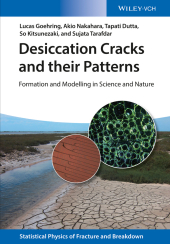 Neuerscheinungen 2015Stand: 2020-02-01 |
Schnellsuche
ISBN/Stichwort/Autor
|
Herderstraße 10
10625 Berlin
Tel.: 030 315 714 16
Fax 030 315 714 14
info@buchspektrum.de |

Tapati Dutta, Akio Nakahara, Sujata Tarafdar
(Beteiligte)
Desiccation Cracks and their Patterns
Formation and Modelling in Science and Nature
1. Auflage. 2015. XVIII, 350 S. 100 SW-Abb. 244 mm
Verlag/Jahr: WILEY-VCH 2015
ISBN: 3-527-41213-1 (3527412131)
Neue ISBN: 978-3-527-41213-6 (9783527412136)
Preis und Lieferzeit: Bitte klicken
Bringing together basic ideas, classical theories, recent experimental and theoretical aspects, this book explains desiccation cracks from simple, easily-comprehensible cases to more complex, applied situations.
The ideal team of authors, combining experimental and theoretical backgrounds, and with experience in both physical and earth sciences, discuss how the study of cracks can lead to the design of crack-resistant materials, as well as how cracks can be grown to generate patterned surfaces at the nano- and micro-scales. Important research and recent developments on tailoring desiccation cracks by different methods are covered, supported by straightforward, yet deep theoretical models.
Intended for a broad readership spanning physics, materials science, and engineering to the geosciences, the book also includes additional reading especially for students engaged in pattern formation research.
INTRODUCTION
Basic Conditions for Crack Formation
Linear Elasticity
Linear Elastic Fracture Mechanics: Griffith and Irwin
Poro-Elasticity
Process of Desiccation
Drying Regimes, Constant Rate/Falling Rate Periods
Water Transport in a Drying Soil: Basics of Capillary Flow and Vapor Transport
How Capillary Forces give Rise to Stresses
Energy Considerations
Driving Force for Cracking during Drying
Length Scales: through-Thickness Cracks, Channel Cracks, Interface Cracks, etc.
Fracture Saturation - Crack Spacing is similar to Layer Thickness
Non-Linear and Dissipative Effects
DYNAMICS AND PATTERNS
Propagation of a Crack - Crack Velocity - self-affine Structure
The Crack Network - 2 dimensional View - self Similarity - fractal Dimension
Instabilities: wavy Cracks, en Echelon/en passant Cracks, Star-Cracks, Wing-Cracks, etc.
Transition from Dendrites to Fracture
Cracks in 3 Dimensions - geological Formations - Cracks in Soil - Cracking versus Peeling
Columnar Joints - Desiccation induced analogue produced in the Lab
Columnar Joints in Lava and Starch, Summary
Scaling: Spacing related to effective Layer Thickness, set by Advection-Diffusion.
Ordering - Cracks interact and evolve from Squares to Hexagons.
Extensions to other Patterns: Permafrost/polygonal Terrain, evolving Mud Cracks, Surface Cracks in erosional Systems.
Practical Applications, estimating Cooling Rate, Conditions during Formation.
THEORETICAL ANALYSIS AND MODELING
Channeling Cracks
Special Solutions; Relation of Channeling to Tunneling cracks
Effects of Substrate Elasticity, Dunders Parameters (Non-Dimensionalization)
TAILORING CRACK PATTERNS
Memory Effect - Effect of Vibration, Rotation and Flow
Effect of Fields - Electric - DC and AC and Magnetic
NUMERICAL METHODS:
Random Fuse Models
Spring Network Models
Other Models
POSSIBLE APPLICATIONS OF STUDY OF CRACKS
Designing Crack resistant Materials and Composites
Controlling Crack Formation for Micro to Nano-Scale Patterning
CONCLUSION


